Podcast
Questions and Answers
Which hominin ancestors are particularly highlighted in the Lower Paleolithic period?
Which hominin ancestors are particularly highlighted in the Lower Paleolithic period?
- Homo neanderthalensis
- Australopithecus and Homo erectus (correct)
- Homo habilis and Homo ergaster
- Homo sapiens
What type of stone tools were primarily used during the Lower Paleolithic period?
What type of stone tools were primarily used during the Lower Paleolithic period?
- Microliths
- Flake tools
- Mousterian tools
- Acheulean handaxes and cleavers (correct)
Which behavior was notably present in both Homo sapiens and Neanderthals during the Middle Paleolithic?
Which behavior was notably present in both Homo sapiens and Neanderthals during the Middle Paleolithic?
- Extensive farming practices
- Building permanent settlements
- Hunting and gathering (correct)
- Advanced metalworking
What distinguished the Mousterian stone tool kit from those used in the Lower Paleolithic?
What distinguished the Mousterian stone tool kit from those used in the Lower Paleolithic?
During which period did modern humans begin to flourish and Neanderthals decline?
During which period did modern humans begin to flourish and Neanderthals decline?
What key features characterize the Mesolithic period?
What key features characterize the Mesolithic period?
What kind of cultural practices likely continued into the Mesolithic period?
What kind of cultural practices likely continued into the Mesolithic period?
What emergent behavior reflects the development of controlled use of fire during the Lower Paleolithic?
What emergent behavior reflects the development of controlled use of fire during the Lower Paleolithic?
Which technological advancement did NOT originate in medieval China?
Which technological advancement did NOT originate in medieval China?
What was a primary characteristic of the feudal system in Europe?
What was a primary characteristic of the feudal system in Europe?
Which of the following universities was established earliest in Europe?
Which of the following universities was established earliest in Europe?
What method of diagnosis was commonly used in medieval medicine?
What method of diagnosis was commonly used in medieval medicine?
Which of the following was NOT a major discovery or invention in Europe during the Middle Ages?
Which of the following was NOT a major discovery or invention in Europe during the Middle Ages?
In Indian advancements, what system was developed for calculating?
In Indian advancements, what system was developed for calculating?
What was the primary unit of currency in the Mayan civilization?
What was the primary unit of currency in the Mayan civilization?
Who is known as the 'Father of Modern Chemistry'?
Who is known as the 'Father of Modern Chemistry'?
Which scientist confirmed that planets rotate in ellipses rather than perfect circles?
Which scientist confirmed that planets rotate in ellipses rather than perfect circles?
What type of knowledge was notably advanced in medieval India?
What type of knowledge was notably advanced in medieval India?
What idea did Paracelsus challenge in his medical practices?
What idea did Paracelsus challenge in his medical practices?
Who was the first to show that Earth revolves around the Sun?
Who was the first to show that Earth revolves around the Sun?
Which scientist operated an observatory built by the king of Denmark?
Which scientist operated an observatory built by the king of Denmark?
What was a major philosophical contribution of Francis Bacon?
What was a major philosophical contribution of Francis Bacon?
Which of the following best describes Tycho Brahe's belief regarding the universe?
Which of the following best describes Tycho Brahe's belief regarding the universe?
What law did Robert Boyle discover that relates gas pressures to volume?
What law did Robert Boyle discover that relates gas pressures to volume?
What major discovery is Galileo Galilei known for in relation to astronomy?
What major discovery is Galileo Galilei known for in relation to astronomy?
Which philosophical statement is associated with René Descartes?
Which philosophical statement is associated with René Descartes?
What was one of Isaac Newton's contributions to physics?
What was one of Isaac Newton's contributions to physics?
What was a central idea of the Enlightenment?
What was a central idea of the Enlightenment?
What aspect of the universe did Newton's discoveries primarily focus on?
What aspect of the universe did Newton's discoveries primarily focus on?
How did Galileo's views challenge the established beliefs of his time?
How did Galileo's views challenge the established beliefs of his time?
What method did Descartes promote in his writings?
What method did Descartes promote in his writings?
What did Enlightenment thinkers believe about societal problems?
What did Enlightenment thinkers believe about societal problems?
What was a primary focus of the movement during the Industrial Revolution?
What was a primary focus of the movement during the Industrial Revolution?
Which material was primarily utilized during the Industrial Revolution?
Which material was primarily utilized during the Industrial Revolution?
Which of the following energy sources played a significant role in the Industrial Revolution?
Which of the following energy sources played a significant role in the Industrial Revolution?
What was one of the socioeconomic changes resulting from the Industrial Revolution?
What was one of the socioeconomic changes resulting from the Industrial Revolution?
What type of changes reflected the shift in economic power during the Industrial Revolution?
What type of changes reflected the shift in economic power during the Industrial Revolution?
What sweeping social change was associated with the Industrial Revolution?
What sweeping social change was associated with the Industrial Revolution?
How did workers' roles change during the Industrial Revolution?
How did workers' roles change during the Industrial Revolution?
What psychological change was observed as a result of the Industrial Revolution?
What psychological change was observed as a result of the Industrial Revolution?
Flashcards are hidden until you start studying
Study Notes
Lower Paleolithic Period
- Characterized by the evolution of hominin ancestors, including Australopithecus and Homo erectus/Homo ergaster.
- Stone tools included Acheulean handaxes and cleavers, suggesting scavenging was more prevalent than hunting.
- Sites contain extinct animal remains from the Early or Middle Pleistocene.
- Evidence suggests controlled use of fire emerged during this period.
Middle Paleolithic Period (ca. 200,000-45,000 years ago)
- Emergence and flourishing of archaic humans, including Homo sapiens neanderthalensis.
- Continued use of handaxes, alongside the development of Mousterian toolkits (prepared cores and specialized flake tools).
- Subsistence strategies included scavenging, hunting, and gathering.
Upper Paleolithic Period (40,000-10,000 years BP)
- Neanderthals disappeared from Europe by 33,000 years ago, leaving Homo sapiens as the dominant species.
- Significant advancements in human behavior, although a gradual development rather than a sudden "creative explosion".
Mesolithic ("Middle Stone") Period
- Transitional period between Paleolithic and Neolithic periods.
- Defined by the use of small chipped stone tools (microliths and retouched bladelets).
- Continuation of Upper Paleolithic artistic traditions (cave paintings, engravings, sculptures, megalithic architecture).
Major Chinese Technological Advancements (Middle Ages)
- Papermaking
- Seismograph
- Animal harness
- Water-power technologies
- Mechanical clock
- Hydraulic engineering works
- Wheelbarrow
- Gunpowder, guns, and cannons
- Printing press
- Magnetic compass and stern-post rudder
Europe (Middle Ages): Economy
- Feudal system dominated, with local agricultural and handicraft production.
- Hierarchical social structure: peasants, lords, lay/clerical overlords, kings/bishops, pope/emperor.
Europe (Middle Ages): Education
- Establishment of cathedral schools, evolving into universities.
- Notable universities: Paris (1160), Oxford (1170), Cambridge (1209), Padua (1221), St. Andrews (1410), Naples (1224), Salamanca (1227), Prague (1347), Vienna (1367).
Europe (Middle Ages): Major Discoveries and Inventions
- Horse-collar
- Clocks/watches
- Magnetic compass
- Water-mills and windmills
- Lenses (spectacles)
- Gunpowder and cannons
- Paper and printing
Europe (Middle Ages): Medicine
- Prevalence of superstition and dogmatism.
- Diagnosis primarily based on urine inspection.
- Treatments involved magic, prayer, charms, faith healing, and herbal remedies.
- Poor hygiene and sanitation.
India (Middle Ages): Science
- Compilation of information on diseases, drugs, and astronomy.
- 12-month, 360-day calendar.
- Knowledge of square roots, linear equations, zero, and decimal place values.
- Naturally based medicine (symptom-based diagnosis).
- Development of metallurgy.
Pre-Columbian America: Mayan Civilization (Economy)
- Cocoa beans used as currency.
Pre-Columbian America: Mayan Civilization (Astronomy)
- Decimal notation system, with zero represented by an oval shape. Other numbers represented by dots and dashes.
Robert Boyle (1627–1691)
- "Father of Modern Chemistry" due to experimental methods.
- Boyle's Gas Law (relationship between gas pressure and volume).
- Believed in the existence of atoms.
Paracelsus (1493–1541)
- Rejected traditional humor-based medicine.
- Focused on chemical causes of illness.
- Supported Hermetic Doctrine and studied alchemy.
Tycho Brahe (1546–1601)
- Believed in a geocentric universe (Earth-centered).
- Conducted detailed astronomical observations over 20 years.
- Demonstrated that stars were not fixed in position.
Johannes Kepler (1571–1630)
- Used Tycho Brahe's data to confirm heliocentric model (Sun-centered).
- Developed three laws of planetary motion:
- Elliptical orbits
- Variable planetary speed based on distance from the sun.
- Mathematical calculation of planetary orbits.
Nicolaus Copernicus (1473–1543)
- Proposed a heliocentric model of the solar system.
- Published his findings in the year of his death, initiating the Copernican Revolution.
Francis Bacon (1561–1626)
- Advocated for empirical method and inductive reasoning.
- Rejected reliance on authority in favor of observation-based knowledge.
Galileo Galilei (1564–1642)
- Promoted experimental physics and observational astronomy.
- Discovered new moons and planetary laws using telescopes.
- Challenged the Church's geocentric view, leading to conflict with the Inquisition.
René Descartes (1596–1650)
- Mathematician and philosopher who promoted deductive reasoning.
- Emphasized the importance of proof through logical chains.
- Famous for "I think, therefore I am."
Isaac Newton (1642–1726)
- Discovered calculus and three laws of motion:
- Inertia
- Force = mass x acceleration
- Action-reaction
- Developed the Newtonian Universe concept, emphasizing mathematical descriptions of matter in motion.
The Enlightenment
- Intellectual movement (late 17th-early 18th centuries).
- Emphasized natural law's application to society and human nature.
- Optimistic belief in progress and the possibility of improving society.
- Secular focus on economic and social improvement.
The Industrial Revolution
-
Technological changes:
- New materials (iron, steel)
- New energy sources (coal, steam engine, electricity, petroleum, internal combustion engine)
- New machines (spinning jenny, power loom)
-
Socioeconomic and cultural changes:
- Agricultural improvements
- Wealth redistribution
- Increased international trade
- Political shifts
- Urban growth, working-class movements
- Changes in work skills and social relations
- Increased confidence in human mastery of nature.
Studying That Suits You
Use AI to generate personalized quizzes and flashcards to suit your learning preferences.



